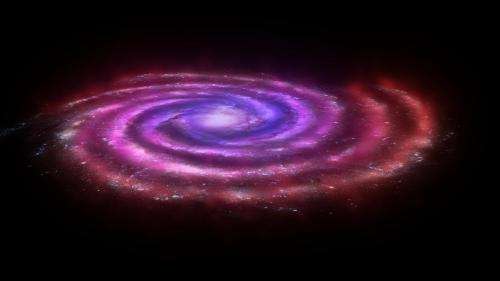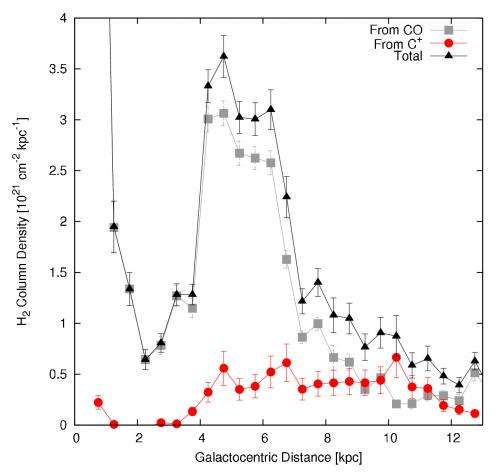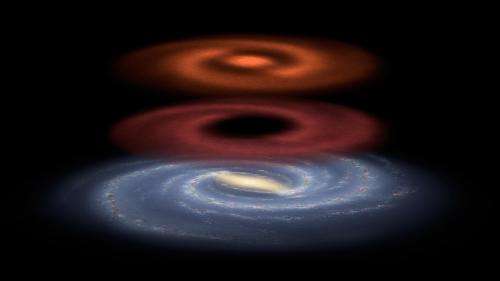There is more gas in the Galaxy than is dreamt of by astronomers

(Phys.org) —A survey from Herschel has revealed that the reservoir of molecular gas in the Milky Way is hugely underestimated - almost by one third - when it is traced with traditional methods. Monitoring the emission from ionised carbon, the new study identified molecular gas in the intermediate evolutionary stage between diffuse, atomic gas and the densest star-forming molecular clouds. The discovery not only indicates that there is more raw material for the formation of new stars in the Galaxy, but also that it extends farther than astronomers knew.
In the Milky Way, as well as in other galaxies, stars are born from the collapse of the densest and coldest clumps of matter in a molecular cloud. These clouds are gigantic star-forming complexes consisting mainly of molecular hydrogen (H2), a gas that does not emit any light at the low temperatures found in molecular clouds.
Astronomers investigating the early stages of star formation are not only interested in how molecular clouds fragment to form stars, but also in the processes that take place even earlier and initially cause molecular clouds to take shape from diffuse, atomic hydrogen gas. For this purpose, astronomers study the distribution and properties of H2 across the Galaxy – but without the benefit of direct observations, they must resort to alternative methods to trace it.
The most widely used proxy to track down molecular gas in star-forming regions is carbon monoxide (CO). A mere contaminant in molecular clouds, CO radiates much more efficiently than H2 and can be detected easily. However, such indirect tracers can be biased, since there is no guarantee that all portions of a cloud containing H2 also contain CO, in which case observations of CO would miss these regions entirely.
To achieve a more complete picture of the Milky Way's molecular content, astronomers in the past decades have combined observations of CO with other tracers of H2. These include the emission from dust – another contaminant in molecular clouds – and the gamma rays that are produced when cosmic ray particles interact with atomic and molecular hydrogen in the interstellar medium (ISM).
The combination of such data had suggested the presence of more molecular gas in the Milky Way than indicated by CO alone. New data from ESA's Herschel Space Observatory are now confirming this earlier suspicion: almost one third of all molecular gas in the Milky Way had remained undetected. And there is more: the new survey, which probes H2 through a different tracer – ionised carbon (C+) – has established the three-dimensional distribution of the molecular gas across the Milky Way.
"This is the first survey of ionised carbon across the Galactic Plane – where most of the Milky Way's stars and star-forming clouds are concentrated – that combines both high spectral and angular resolution," comments Jorge Pineda from the Jet Propulsion Laboratory (JPL), Caltech, USA, who led the study.

"With the unprecedented spectral resolution of the HIFI instrument on board Herschel, we could estimate the distance of the emitting C+ from the Galactic Centre and reconstruct its radial distribution across the Galaxy."
Ionised carbon derives from carbon atoms that have been stripped of one of their outermost electrons by ultraviolet photons from nearby young stars. These ions are present in traces throughout the ISM and produce a characteristic line emission at a wavelength of 158 microns. The C+ line is the brightest emission feature from the ISM at far-infrared wavelengths. However, due to absorption by the Earth's atmosphere, astronomers can only observe the C+ line from above most of the atmosphere, preferably from space.
"Carbon atoms are ionised by the same ultraviolet photons that break H2 molecules apart into hydrogen atoms, but these two processes don't quite happen in the same places in the ISM," explains co-author William Langer, also from JPL, Caltech, USA. Langer is the Principal Investigator of GOT C+, the Herschel Open Time Key Programme within which the data were collected.
"So we can use the C+ line to pinpoint gas in a crucial, transitional phase where most hydrogen is molecular but carbon is mainly ionised."
To identify the different environments where the detected C+ emission originated, the astronomers compared the Herschel data with other, independent observations that trace the various components of the ISM. But they could account for just less than three quarters of all they saw with Herschel.
"We realised the remaining ionised carbon must be located in some secluded portions of the molecular clouds that we can't trace through CO because they don't contain this molecule at all," explains Pineda.
The densest pockets of the ISM, where the bulk of molecular gas resides, contain both H2 and CO. But their immediate surroundings have a more complex composition, which is deeply influenced by ultraviolet radiation from nearby stars. These photodissociation regions comprise several layers: in the outermost ones gas is fully ionised due to the exposure to ultraviolet radiation, while the inner layers host different gas species at the same time – ionised, atomic, and molecular.

In one of the innermost layers of a photodissociation region, H2 and C+ are found to coexist. Astronomers call molecular gas located there 'CO-dark' H2 to distinguish it from H2 mixed with carbon monoxide that can be traced via CO emission. The new Herschel data show that CO-dark H2 accounts for about 30 per cent of the Milky Way's entire reservoir of molecular gas.
"The Galaxy contains much more H2 than we thought – we just needed to look at it from a new perspective," comments Langer.
Not only does the Herschel C+ survey uncover this hidden pool of material for potential future stars, but it also reveals that it is distributed in a curious way. The CO-dark H2 detected with Herschel is mostly located in a ring surrounding the centre of the Galaxy at radii between 13 000 and 36 000 light-years. This extends much farther than CO-traced molecular gas, which is most concentrated in the innermost regions of the Galaxy, peaking at a radius of about 13 000 light-years, and declining in density at greater distances.
The astronomers plan to study the newly detected molecular gas in greater detail to inspect the intermediate steps that turn the diffuse ISM into denser and colder molecular clouds. The amount of H2 in a galaxy is a key parameter to understand its star formation activity, but the rate at which molecular gas is produced in the first place might be equally important.
"This exciting work based on C+ observations made by Herschel not only shows there is definitely much more raw material available for star formation in our Galaxy than we knew, which is important in its own right," comments Göran Pilbratt, Herschel Project Scientist at ESA, "but thanks to the high spectral resolution provided by HIFI we can also say where this gas is."
More information: Technical paper: J. L. Pineda, et al., "A Herschel [C II] Galactic plane survey I: the global distribution of ISM gas components", 2013, Astronomy & Astrophysics, 554, A103. arxiv.org/abs/1304.7770 and dx.doi.org/10.1051/0004-6361/201321188
Journal information: Astronomy & Astrophysics
Provided by European Space Agency



















